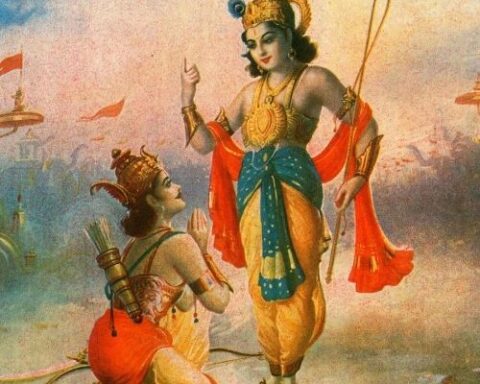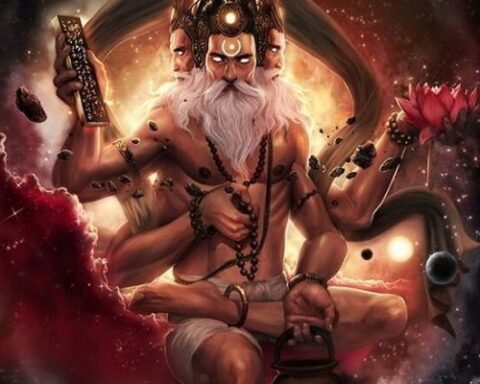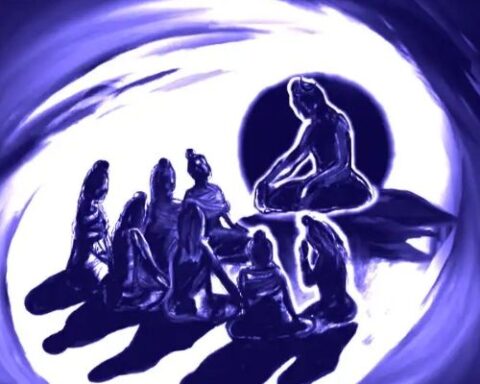The word dharma comes from the Sanskrit root word dhri, which means “to hold,” “to maintain,” or “to preserve.” In the early Vedas and other ancient Hindu texts, dharma referred to the cosmic law that created the ordered universe from chaos. Later, it was applied to other contexts, including human behaviours and ways of living that prevent society, family and nature from descending into chaos.
This included the concepts of duty, rights, religion and morally appropriate behaviour, and so dharma came to be understood as a means to preserve and maintain righteousness.
It is said that all beings must accept their dharma for order and harmony to exist in the world. If an individual is following their dharma, they are pursuing their truest calling and serving all other beings in the universe by playing their true role.
On an individual level, dharma can refer to a personal mission or purpose. Traditionally, an individual’s dharma is thought to be pre-determined depending on karma.
What is the Law of Dharma?
In ancient times, Dharma meant the universal laws of nature, which apply to everyone. Even today, we come across Dharma being used in this sense. For example, it is the Dharma of fire to burn and to cause to burn. Here, Dharma has nothing to do with any religion but means the nature of fire. How can fire be Buddhist, Christian, Hindu, Muslim, Parsi or Sikh? Fire is fire.
Likewise, ice is ice. The Dharma of ice is to be cold and to cause to cool. This is the nature of ice, which is universal and eternal.
Similarly, when a person develops negativity such as anger, aversion, jealousy, and animosity, he feels unpleasant sensations and becomes miserable.
Neither the mental negativity nor the resultant misery can be called Christian, Hindu, Buddhist or Jain. This is the nature of mental defilements: to make one miserable.
Dharma meaning In different religions
Hinduism – In Hinduism, dharma is the religious and moral law governing individual conduct and is one of the four ends of life. In addition to the dharma that applies to everyone (sadharana dharma — consisting of truthfulness, non-injury, and generosity, among other virtues — there is also specific dharma (svadharma) to be followed according to one’s class, status, and station in life. Dharma constitutes the subject matter of the Dharma-sutras, religious manuals that are the earliest source of Hindu law, and with time has been extended into lengthy compilations of law, the Dharma-shastra.
Buddhism – In Buddhism, dharma is the doctrine, the universal truth common to all individuals at all times, proclaimed by the Buddha. Dharma, the Buddha, and the sangha (community of believers) make up the Triratna, “Three Jewels,” to which Buddhists go for refuge. In Buddhist metaphysics, the term in the plural (dharmas) is used to describe the interrelated elements that make up the empirical world.
Jainism – In Jain philosophy, dharma, in addition to being commonly understood as a moral virtue, also has the meaning — unique to Jainism — of an eternal “substance” (dravya), the medium that allows beings to move.
What Makes You Dharmic?
Anything that helps a human being to reach god is dharma and anything that hinders a human being from reaching god is adharma. According to the Bhagavat Purana, righteous living or life on a dharmic path has four aspects: austerity (tap), purity (Shudh), compassion (daya) and truthfulness (Satya); and adharmic or unrighteous life has three vices: pride (ahankar), contact (Sangh), and intoxication (madya). The essence of dharma lies in possessing a certain ability, power, and spiritual strength. The strength of being dharmic also lies in the unique combination of spiritual brilliance and physical prowess.
Manusmriti which is written by the ancient sage Manu prescribes essential rules for the observance of dharma:
1. Patience – The capacity to accept or tolerate.
2. Forgiveness – Internal process of letting go of feelings and thoughts of resentment.
3. Piety or self-control – The quality of being religious or reverent.
4. Honesty – Honesty is a facet of moral character that connotes positive and virtuous attributes such as integrity, truthfulness and straightforwardness
5. Sanctity – The state or quality of being holy, sacred, or saintly.
6. Control of senses – Sense of control of our 5 senses sight, sound, smell, taste and touch.
7. Reason – The power of the mind to think, understand, and form judgements logically.
8. Knowledge or learning -Knowledge acquired through study, experience, or being taught.
9. Truthfulness – The fact of being realistic or true to life.
10. Absence of anger – Being calm even when insulted, rebuked or despite great provocation.
Manu further writes, “Non-violence, truth, non-coveting, purity of body and mind, control of senses are the essence of dharma”. Therefore dharmic laws govern not only the individual but all in society.
Dharma as the Path
How we respond to the disruption and destabilization caused by eternal dharma, as it shows up in the experiences of our lives, is a matter of choice.
For example, we may fall into avoidance and denial, seeking to reconstitute our solidity, comfort and security. Or we may see in the dharma a harbinger of ultimate reality, and turn to it as the path. The first approach leads us to deny what we have seen and to pretend things are otherwise. This results in further bondage, increased confusion, negative karma, and suffering. The second leads, to recall the words of the Theravadin meditation teacher Ayya Khema said: “It’s not about the elimination of suffering but to the gradual dissolution of the one who suffers.”
Conclusion –
Dharma does not classify an action as right or wrong independent of the circumstances. For example, lying is not categorically wrong – it is right or wrong depending on the circumstances. It might be wrong to lie to avoid punishment, but it might not be wrong to lie to protect state secrets (hence protecting harmony of the nation), or someone’s life. Essentially, if the action sustains harmony, it is dharmic; if the action disrupts harmony, it is not dharmic. The Bhagavad Gita, a part of the epic Mahabharata, and a popular text among Hindus are dedicated to helping Arjuna, a warrior prince, decide whether it is dharmic or not to fight in a war when his family and teachers stand on the other side of the battlefield.
Krishna, mentioned above, shows Arjuna why it is dharmic for him to pick up arms in this situation, and fight the force that is disrupting peace for citizens all over India. Though fighting goes against the idea of ahimsa, Arjuna is a prince, and his dharma is to use his skills to make his kingdom a safe and just place for all of his citizens. Texts like the Bhagavad Gita help individuals understand what their dharma is in challenging situations, especially when the answer isn’t black or white.





